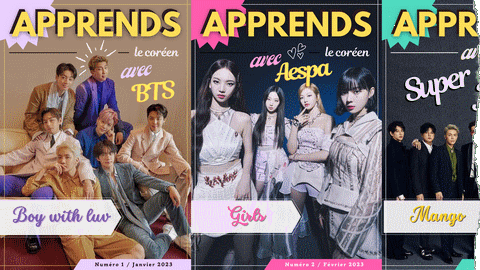Cours de coréen ᚛ Level 1 - My First Steps in Korean (Lessons 1 to 30) ᚛ Leçon 17 - The Present Tense in the Formal Style [-(스)ㅂ니다]
The Present Tense in the Formal Style [-(스)ㅂ니다]
In the previous chapters, we have seen how to conjugate present tense verbs in both casual and polite styles as well as vowel contractions and the many conjugation exceptions. Conjugating verbs in the present tense in the formal style in Korean is much easier than conjugating them in the other politeness levels. Indeed, the formal style has very few exceptions.
The Present Tense in the Formal Style - Normal Case
Korean verbs are conjugated in the formal style as follows:
- If the stem of the verb ends in a vowel: [Stem]ㅂ니다
- If the stem of the verb ends in a consonant: [Stem]습니다
Note: According to Korean nasalization rules, when ㅂ is just before ㄴ, it is pronounced ㅁ. This means that the forms in ㅂ니다 and 습니다 are pronounced respectively [ㅁ니다] and [슴니다].
The verb 가다 (= to go) has a stem 가 which ends in the vowel ㅏ, so we add ㅂ니다 to the stem.
- 가다 → 갑니다. = I go. / You go. / He goes… etc.
The verb 덥다 (= to be hot) has a stem 덥 which ends in the consonant ㅂ, so we add 습니다 to the stem.
- 덥다 → 덥습니다. = It is hot.
The Present Tense in the Formal Style - Exception in ㄹ
Be careful, if the stem of the verb ends in ㄹ, then the construction of the present in the formal style is done as follows:
Remove the final ㄹ from the stem then add ㅂ니다.
The verb 살다 (= to live) has a stem 살 which ends in ㄹ. We first remove the final ㄹ, so we get 사. Then, we add ㅂ니다 to the stem.
- 살다 → 삽니다. = I live. / You live. / He lives… etc.
Summary table of structure
En savoir +
Exercises
En savoir +
Apprends le coréen avec la K-pop est un ensemble de 4 numéros qui permettent d'apprendre de nombreux points de la langue coréenne en se basant sur des chansons coréennes récentes. Pourquoi apprendre le coréen avec des chansons ?
- Pour apprendre du vocabulaire et des expressions dans l'air du temps, utiles dans la vie quotidienne
- Pour pouvoir travailler la prononciation du coréen à l'aide de la chanson étudiée
- Pour voir ou revoir de nombreux points de grammaire disséminés dans les couplets
- Pour s'amuser tout en apprenant des choses, car quoi de plus ludique que nos chansons préférées ?


